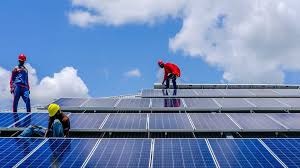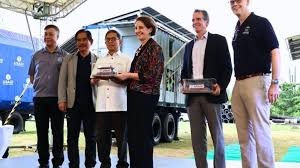The Philippines is leveraging renewable energy as a tool for both inclusive growth and national security. In a landmark clean energy initiative, the Department of Energy (DOE) has deployed a state-of-the-art Mobile Energy System (MEES)—a self-contained, solar-powered unit with advanced battery storage—to Balabac Island. This project, positioned at the southernmost tip of Palawan, is more than a solution to energy poverty; it is a strategic move to solidify the Philippines’ presence in a vital, sensitive maritime frontier.
On October 3, 2025, the DOE, in collaboration with the National Power Corporation (NPC) and the Armed Forces of the Philippines (AFP), launched the system on Balabac. The project is a key component of the U.S. government-funded Energy Secure Philippines Activity (ESPA) program, which aims to promote decentralized, climate-resilient energy systems across the archipelago.
Energy Secretary Sharon Garin emphasized the administration’s holistic approach: “We are not only providing electricity; we are enabling opportunity, security, and resilience for the people of Balabac Island. The MEES deployment stands at the intersection of energy development, national resilience, and geopolitical strategy.”

Balabac: The Strategic Importance of the Southern Frontier
Balabac Island, home to approximately 40,000 residents, holds immense strategic value that far exceeds its size or remote location. Situated near the maritime boundary with Malaysia, the island is a critical outpost for defense operations.
Its location grants it strategic control over vital international sea lanes in the Sulu and Celebes Seas. Electrifying Balabac therefore carries implications that transcend local development, directly contributing to the nation’s ability to maintain maritime security and assert sovereignty in a sensitive border region.
Historically, however, Balabac has suffered from limited and unreliable power, relying on costly, polluting, and logistically challenging diesel generators. Studies indicated that the island is perfectly suited for renewable solutions, with a solar farm of just 1.5 megawatts sufficient to meet its needs until 2030. By transitioning from fossil fuels to solar energy, the government aims to catalyze local industries, improve quality of life, and secure this crucial community that links development with defense.
Technical Innovation: A Mobile Powerhouse in a 20ft Trailer
The MEES deployed to Balabac is a landmark innovation in portable, resilient power.
The entire system is housed within a 20-foot trailer, a deliberate engineering choice that ensures the platform is highly modular and mobile. This flexibility allows for rapid transport via ship, truck, or even aircraft, enabling quick installation even in rugged or isolated terrain. This capability is vital for frontier islands that often face significant logistical barriers to conventional grid infrastructure.
MEES Technical Specifications:
Solar Capacity: $9.18$ kilowatt peak (kWP) of photovoltaic (PV) capacity.
Storage Core: A $102.4$ kWh lithium-based battery system—the heart of the unit—stores excess daytime energy to ensure uninterrupted power through the night or during adverse weather.
Operational Resilience: The system eliminates reliance on diesel fuel, drastically cutting emissions, noise pollution, and maintenance costs while guaranteeing reliability for essential services.
The DOE and NPC note that the MEES’s power generation is sufficient to operate critical community and emergency services, including local schools, rural health units, communications facilities, and command posts that serve as lifelines in disaster or defense situations.
Beyond Development: Security, Savings, and Scalability
The deployment in Balabac has immediate and tangible impacts that validate the system’s multipurpose utility.
1. Social Empowerment and Economic Catalyst
Reliable electricity acts as a catalyst for transformation. Initial beneficiaries, including the Balabac Central School and surrounding communities, now enjoy continuous power. This allows students to study beyond daylight hours and enables clinics to power refrigeration for vaccines and medical supplies. On the livelihood front, stable power allows small enterprises, such as ice storage for fishermen’s catches, to thrive, empowering residents to participate more fully in the modern economy.
2. Economic Efficiency and Environmental Stewardship
Balabac’s shift to solar power dramatically reduces its reliance on imported diesel, which is expensive and logistically burdensome. The $102.4$ kWh system is projected to generate significant annual savings by eliminating fuel-related costs, freeing up public funds for social services.
As DOE Secretary Raphael Lotilla highlighted, “Every peso saved from imported fuel is a peso reinvested into our communities. Every kilowatt hour generated locally strengthens our energy independence.” This move advances the country’s targets under the Philippine Energy Plan (PEP) 2023-2050 to increase the renewable energy share to 35% by 2030.
3. Disaster Resilience and Maritime Security

The MEES’s modular design offers critical advantages in disaster resilience. Previous deployments, such as in Cagayan following severe typhoons, demonstrated its ability to provide immediate electricity for emergency response operations and restore vital communications for local government units.
In Balabac, the system plays an additional role in maritime resilience. Electrifying this frontier island enhances the country’s ability to maintain a continuous security and monitoring presence by providing continuous power for radar, communications, and command facilities. The project effectively fuses energy security with territorial security.
National Blueprint: A Model for the Archipelago
The Balabac MEES is not merely a technical achievement; it is a proof of concept for a broader national framework.
The DOE views the project as a blueprint for scaling up decentralized energy systems in off-grid areas, particularly the Geographically Isolated and Disadvantaged Areas (GIDA). Expansion plans are already in motion to replicate the MEES model across southern Palawan and the Sulu Archipelago, where energy insecurity directly hinders both development and defense readiness.
This initiative is closely tied to the deepening bilateral cooperation with the U.S. under the USAID ESPA program, demonstrating a “whole-of-government” approach where technical expertise, AFP logistical support, and international assistance converge to meet both humanitarian and strategic imperatives.
Looking forward, the DOE is committed to accelerating its renewable energy transition. A major step is the upcoming Green Energy Auction 4 (GEA4), which will feature the Integrated Renewable Energy and Energy Storage System (IRESS) framework. This framework, which combines solar power plants with Battery Energy Storage Systems (BESS), directly reflects the lessons learned from the MEES deployments, ensuring grid stability, load management, and ultimately, a sustainable, self-reliant future for the Philippines.





